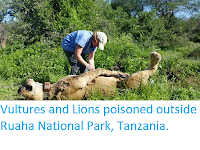Many species of Old World Vultures, Gypaetinae and Aegypiinae, have suffered severe declines in population in recent years, particularly in Africa and Asia, with sixteen of the twenty three species currently listed as Threatened, Endangered or Critically Endangered by the International Union for the Conservation of Nature. Despite considerable conservation efforts in recent years, many of these species have continued to decline, leading to rising concern amongst conservationists. One particular worry is that many of these Bird species may have suffered a decline in genetic diversity, which can reduce the ability of populations to cope with diseases or other crises; this is particularly true when populations become fragmented due to habitat loss, with the effect that each individual population contains only a fragment of the total genetic diversity of the species, so that these smaller populations may be threatened by the effects of inbreeding even thought the total population is quite large.
The Cape Vulture, Gyps coprotheres, is a Southern African species currently considered to be Endangered under the terms of the International Union for the Conservation of Nature's Red List of Threatened Species. This species was formerly found across Southern Africa, from the Democratic Republic of Congo, Zambia, Zimbabwe, and northern Mozambique, south as far as the Cape of Good Hope. The Species is now absent from parts of the northern and possibly the eastern extent of this range, but more worryingly now only breeds at a very limited number of sites in South Africa, Lesotho, and Botswana, with sightings of the Birds in other areas almost exclusively of young Birds, which range widely after fledging but tend to return to the area where they hatched when they reach breeding age.
In a paper published in the journal Scientific Reports on 2 April 2019, Courtneë Kleinhans and Sandi Willows-Munro of the School of Life Sciences at the University of KwaZulu-Natal, describe the results of a genetic study of Cape Vulture breeding populations at six breeding colonies in South Africa.
Kleinhans and Willows-Munro collected genetic samples from Cape Vultures 24 sites around six breeding colonies in South Africa, at Potberg, Collywobbles, Msikaba, Umzimkulu, Skeerpoort, and Kransberg. The genetic material was obtained from feathers, Vultures that had died from a variety of causes, blood samples from Vultures captured as part of a program to fit Birds with GPS tracking systems, and museum specimens from known points of origin. In addition to Cape Vultures, three other Vulture species present were sampled, these being the Near Threatened Bearded Vulture, Gypaetus barbatus; the Critically Endangered Hooded Vulture, Necrosyrtes monachus; and the Critically Endangered White-backed Vulture, Gyps africanus.
A Cape Vulture, Gyps coprotheres. Chris Van Rooyen/Project Vulture.
In a paper published in the journal Scientific Reports on 2 April 2019, Courtneë Kleinhans and Sandi Willows-Munro of the School of Life Sciences at the University of KwaZulu-Natal, describe the results of a genetic study of Cape Vulture breeding populations at six breeding colonies in South Africa.
Kleinhans and Willows-Munro collected genetic samples from Cape Vultures 24 sites around six breeding colonies in South Africa, at Potberg, Collywobbles, Msikaba, Umzimkulu, Skeerpoort, and Kransberg. The genetic material was obtained from feathers, Vultures that had died from a variety of causes, blood samples from Vultures captured as part of a program to fit Birds with GPS tracking systems, and museum specimens from known points of origin. In addition to Cape Vultures, three other Vulture species present were sampled, these being the Near Threatened Bearded Vulture, Gypaetus barbatus; the Critically Endangered Hooded Vulture, Necrosyrtes monachus; and the Critically Endangered White-backed Vulture, Gyps africanus.
Distribution of Gyps coprotheres. Extant and extinct geographical distribution of Gyps coprotheres is shown. The 24 sampling localities for the 605 Gyps coprotheres included in the present study are shown (black dots). White dots indicate the six breeding colonies. Northern, Middle and Western regional grouping are also shown. Kleinhans & Willows-Munro (2019).
Surprisingly, the sampled Cape Vultures were less genetically diverse than the other three species, including the Critically Endangered Hooded and White-backed Vultures. Some of the Cape Vultures sampled also showed signs of inbreeding, as did some of the Near Threatened Bearded Vultures (although the South African population of this species is known to be small and isolated, so it this is not a total surprise), but not the Critically Endangered Hooded and White-backed Vultures. Some of the Cape Vultures.
Surprisingly, the sampled Cape Vultures were less genetically diverse than the other three species, including the Critically Endangered Hooded and White-backed Vultures. Some of the Cape Vultures sampled also showed signs of inbreeding, as did some of the Near Threatened Bearded Vultures (although the South African population of this species is known to be small and isolated, so it this is not a total surprise), but not the Critically Endangered Hooded and White-backed Vultures. Some of the Cape Vultures.
The Cape Vultures did not appeared to be completely tied to reproducing in the same nesting areas as where they were raised (something which can cause severe problems for species in which reproducing populations fall too small), but rather the colonies could be grouped into three regional populations; with Birds apparently moving freely between the Skeerpoort and Kransberg colonies in the north of the country, and between the Collywobbles, Msikaba, and Kransberg colonies in the east. The Potberg colony in the Western Cape was isolated from the other colonies, and the Birds there showed the lowest level of genetic diversity, which was not unexpected as this colony is already considered at risk and is being monitored carefully.
See also...
See also...
Follow Sciency Thoughts on Facebook.








